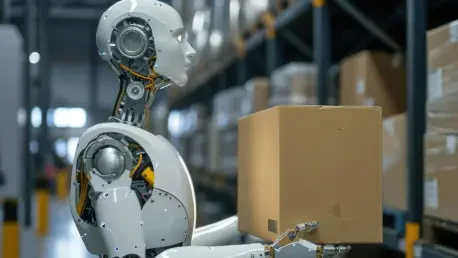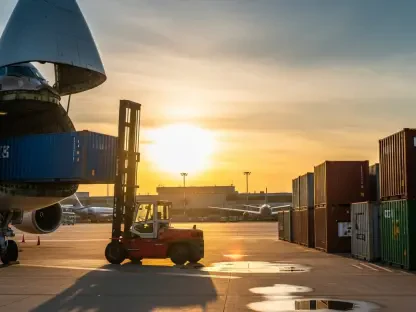The manufacturing sector stands at a pivotal moment where efficiency and innovation are no longer just goals but absolute necessities to remain competitive in a rapidly evolving global market. With over 95% of manufacturing leaders planning to invest in artificial intelligence (AI) within the next few years, according to recent industry reports, the integration of AI into smart manufacturing has become a transformative force. This review delves into the capabilities of AI technologies, exploring how they redefine production processes, optimize operations, and address long-standing industry challenges. The focus is on understanding the core components, recent trends, real-world applications, and the hurdles that still lie ahead in this technological revolution.
Core Features and Performance of AI in Smart Manufacturing
Machine Learning for Process Optimization
AI’s strength in smart manufacturing largely stems from machine learning algorithms that process vast datasets to streamline production workflows. These algorithms can predict equipment failures before they occur, reducing downtime by analyzing historical and real-time data from factory floors. The accuracy of these predictions often surpasses traditional methods, with some systems achieving over 90% reliability in identifying maintenance needs, thereby saving significant costs.
Beyond maintenance, machine learning enhances decision-making by providing actionable insights into process inefficiencies. For instance, it can adjust production schedules dynamically to account for supply chain disruptions or demand fluctuations. Performance metrics like cycle time reduction and output consistency highlight the tangible benefits, positioning machine learning as a critical tool for manufacturers aiming to stay agile in a competitive landscape.
Robotics and Automation
Another cornerstone of AI in manufacturing is its application in robotics, where precision and safety are paramount. AI-driven robotic systems handle repetitive tasks such as assembly or packaging with unparalleled accuracy, often outperforming human labor in speed and error reduction. These systems adapt to varying production needs through advanced vision and sensor technologies, ensuring flexibility on the factory floor.
The performance of robotic automation is evident in metrics like production rate increases and workplace injury reductions. Real-world deployments in automotive plants showcase robots working alongside human operators, enhancing output while maintaining strict safety standards. This synergy not only boosts efficiency but also redefines the role of human workers, shifting their focus to more strategic tasks.
Recent Innovations Shaping AI in Manufacturing
The landscape of AI in smart manufacturing continues to evolve with cutting-edge advancements that push the boundaries of what is possible. Generative AI, for instance, is emerging as a tool for designing optimized production layouts and prototyping machinery components, significantly reducing development timelines. This innovation allows manufacturers to experiment with multiple design scenarios virtually before physical implementation.
Edge computing is another trend gaining traction, enabling real-time data processing directly at the source on factory floors. This minimizes latency and enhances decision-making speed, crucial for time-sensitive operations. Additionally, the growing focus on cybersecurity ensures that AI systems are protected against data breaches, a concern amplified by the increasing connectivity of manufacturing environments.
Industry behavior reflects these shifts, with substantial investments pouring into technology adoption. Reports indicate a strong emphasis on integrating AI securely behind firewalls to safeguard proprietary data. This strategic focus on both innovation and protection underscores the industry’s commitment to leveraging AI for sustainable growth over the coming years.
Real-World Impact Across Manufacturing Sectors
AI’s practical applications span diverse manufacturing sectors, demonstrating its versatility in solving unique operational challenges. In the automotive industry, AI-powered quality control systems detect defects in real-time during assembly, ensuring that only flawless products reach the market. This capability has led to measurable improvements in customer satisfaction and reduced recall costs.
In aerospace, AI optimizes supply chain logistics by predicting material needs and coordinating just-in-time deliveries, minimizing inventory overhead. Meanwhile, consumer goods manufacturers utilize predictive maintenance to keep production lines running smoothly, avoiding costly interruptions. These varied use cases highlight how AI tailors solutions to specific industry demands, driving efficiency at every level.
A particularly compelling example lies in smaller-scale manufacturers adopting AI for customized production runs. By analyzing customer data, AI systems enable these companies to offer personalized products without sacrificing speed or cost-effectiveness. Such adaptability showcases the technology’s potential to democratize advanced manufacturing capabilities across business sizes.
Challenges Hindering Widespread Adoption
Despite its promise, AI in smart manufacturing faces significant barriers to full integration. Technical challenges such as data interoperability between legacy systems and modern AI platforms often stall implementation. Many factories operate on outdated infrastructure, making seamless data integration a complex and costly endeavor.
Regulatory concerns also pose obstacles, particularly around data privacy as AI systems handle sensitive operational information. Compliance with varying global standards adds another layer of difficulty for multinational manufacturers. Moreover, the high initial investment required for AI adoption can deter smaller firms, even though long-term savings are substantial.
Workforce implications further complicate the picture, as the shift toward automation raises questions about job displacement. Addressing this requires reskilling initiatives to prepare employees for new roles alongside AI systems. Industry efforts to develop scalable solutions and advocate for supportive policies aim to mitigate these hurdles, but progress remains uneven across regions.
Future Potential and Emerging Horizons
Looking ahead, AI in smart manufacturing holds immense potential to revolutionize the industry further through autonomous production systems. These systems could manage entire factory operations with minimal human intervention, optimizing resource use and reducing errors. Such advancements are poised to address persistent labor shortages by automating complex tasks.
Sustainability is another area where AI could make a profound impact, with algorithms designed to minimize energy consumption and waste during production. This aligns with global pushes for greener manufacturing practices, positioning AI as a key enabler of environmental goals. The technology’s role in enhancing efficiency also promises to strengthen global competitiveness for adopting firms.
The trajectory suggests a deepening integration of AI into every facet of manufacturing, from design to delivery. As breakthroughs continue, the focus will likely shift toward creating accessible tools for smaller manufacturers, ensuring that the benefits of AI are not limited to industry giants. This democratization could reshape market dynamics significantly in the near future.
Final Thoughts on AI’s Role in Manufacturing
Reflecting on this exploration, AI proves to be a game-changer in smart manufacturing, with its robust features in machine learning and robotics delivering measurable improvements in efficiency and safety. The innovations witnessed in generative AI and edge computing underscore the technology’s dynamic evolution, while real-world applications across sectors demonstrate its practical value. Challenges like data integration and regulatory compliance do temper the pace of adoption, yet the industry shows resilience in tackling these issues head-on.
Moving forward, manufacturers should prioritize strategic planning to harness AI’s full potential, focusing on tailored roadmaps that address specific operational pain points. Investing in workforce training to complement AI integration emerges as a critical step, ensuring that human expertise amplifies technological gains. Additionally, keeping abreast of policy changes and cybersecurity advancements is vital to safeguard progress, setting the stage for a more resilient and innovative manufacturing landscape.









